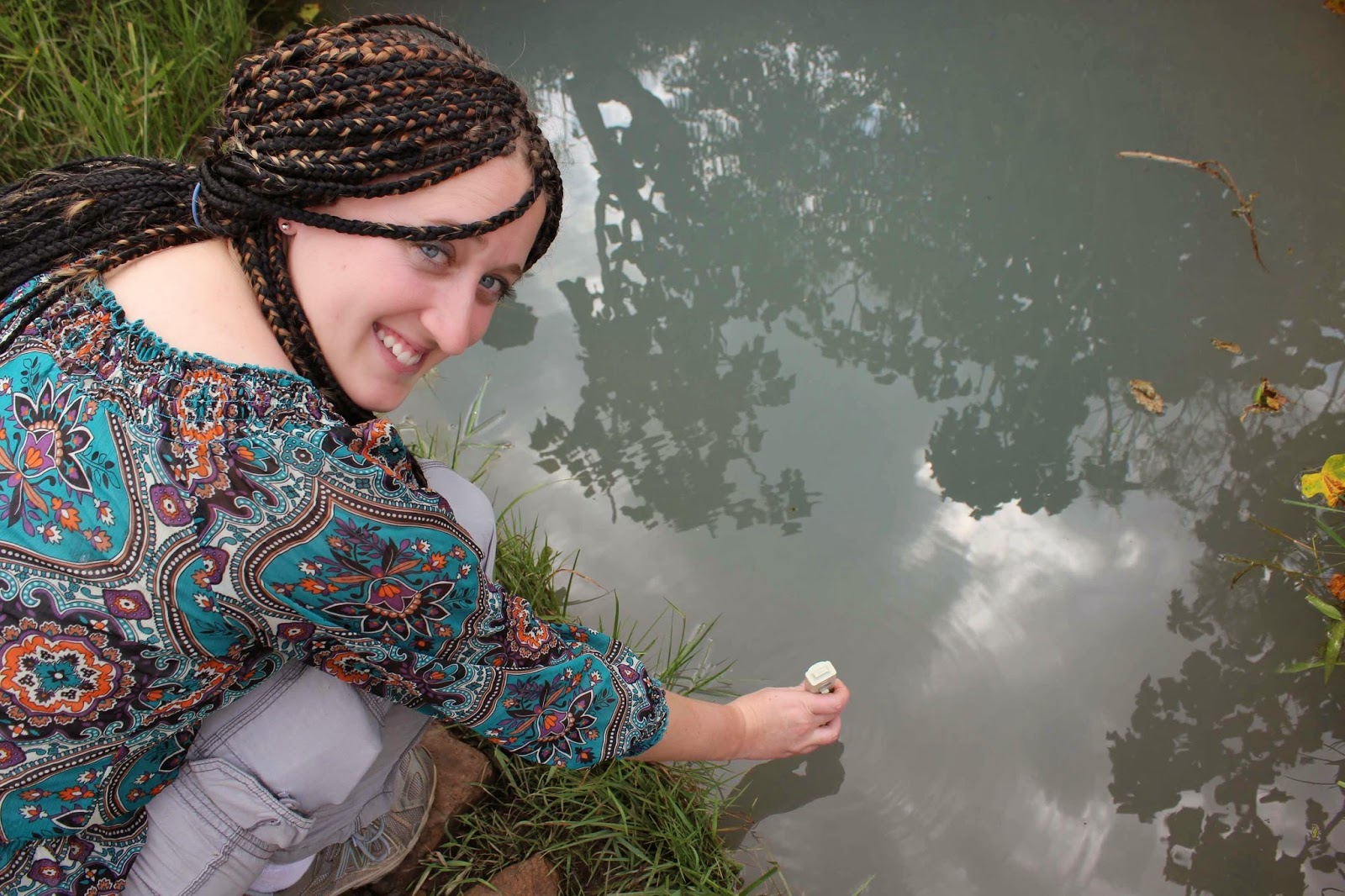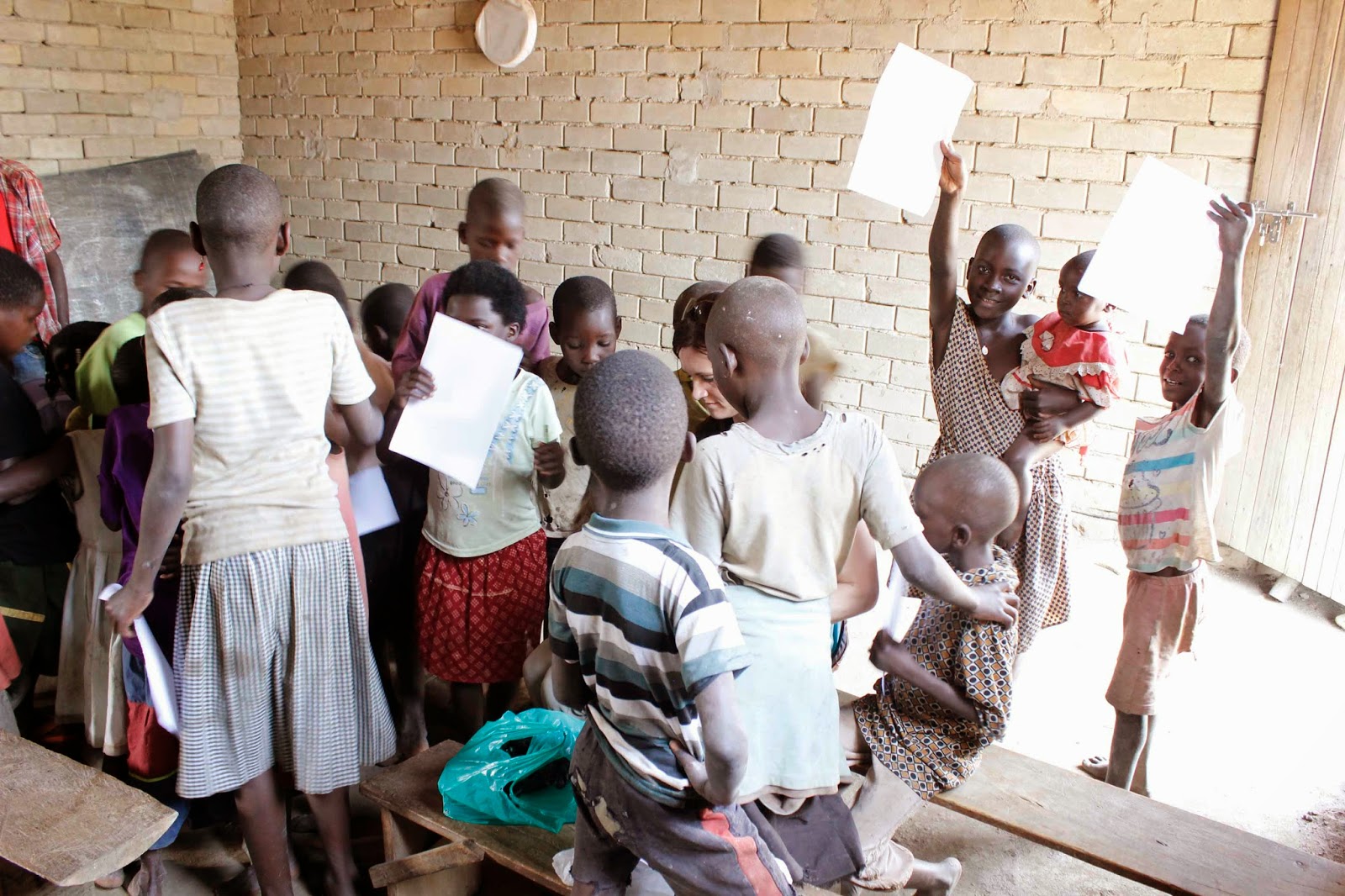BUSSI ISLAND
Friday we packed up most of the team and took the journey to Byana Mary Hill orphanage and school. Earlier in the week Roger, Brian and Reese had been visiting to install swing sets. We brought supplies, tested their water sources, and talked with the leaders about what their needs are and what the IHA/EWB teams can help with in the future.
View of Masaka; at Byana Mary Hill Orphanage...notice the fun reminders
on the trees; spring that supplies their water; Nikki testing water; our
tour guide; Scott touring grounds, checking out holding tank; classrooms;
Alexa obeying the rules...just in time!
While touring the layout of the land, the children entertained us with a dance party...there’s always time to take a moment and do a little dancing.
The team piled in the van and we headed for Bussi Island, where we would visit the Good Day Orphan School. It was a 4 hour journey along main roads, side roads, and roads that warrant their own rating on the richter scale. As Abdul, our trusty driver, says, “This is African massage. You like African massage?” Well...it’s no Swedish massage, but...sure?
We finally arrived to the water’s edge of Lake Victoria. Bussi Island is so small, they didn’t even know about it airport customs when asked where we would be staying. We took a small boat ferry out to the island, and were greeted there by Charles. He and his wife Irene are the directors of the Good Day Orphan School.
beautiful children at ferry port
on the boat to Bussi
Charles, director of Good Day Orphanage and School
The school is home to about 50 students, half of which are orphans. In total however, nearly 400 students attend the school on a daily basis, coming from all over the island. Did you catch that? FOUR HUNDRED. Below are photos of the span of the schoolyard. Charles and Irene house the orphans and boarding students in their own home. What was once their home has now been divided into dormitories to give these children a place to sleep.
View of ramshackle classrooms on left,
roofless new classrooms in distance at right
chicken coop and shed in middle of grounds
view of dormitories/house of Charles and Irene.
The bunkbeds were falling apart due to termites so they had
to remove them
Upon arrival, we were again greeted by the mob of children, who were banging on drums, cheering and yelling “Mizungu! Mizungu!”
The main needs at Good Day include wells, cleaner water, school supplies, and most of all a roof for their new classrooms. The children took us on a tour around the grounds. Seven-year-old Kevin, the obvious group leader and surely meant for politics or sales some day, took Alexa on a tour around the grounds. His English was unbelievably good, as were his manners and presentation skills. He took her into the school to show her what they need:
“We need desks,” as he pointed to the small pile of unusable desks that are being eaten by termites. Children would suddenly crash to the ground as the legs of the desks would give out. He took Alexa out to a nearby tree which had a small chalkboard nailed to its trunk: “We need a roof on our new classrooms. Right now us younger students must have class out by this tree. When it rains, all the students must seek shelter in the school or the house, thus leaving us unable to hold classes until the rain ceases.” Just as the adults in the village know what they need, the students know their needs as well. A simple roof over their unfinished classroom walls might cost $1000 USD. For us, that is nothing to pool together; for them, it is years away if that. These are ways we can help, and you can see that it is not for not, and in no way frivolous.

One of the most heart-wrenching turned heart-warming stories is of Sara, a little blind girl that Charles and Irene gladly took in after hearing of her abandonment. Sara’s parents both abandoned her, leaving her screaming in her home until a neighbor finally checked on her. She had been left, possibly due to the expense and challenge of raising a child with a disability. Charles and Irene heard about her and took her in. A sponsor heard about her story and has gifted payment to send her to a special school on the mainland directed toward children with disabilities. What would be near impossible for many in Uganda, is something someone or a group of individuals here could provide without too much trouble.
Stella and Sara
Stella met with the women in the village and others on Bussi Island to go over the micro-lending, check up on progress, and again present the savings program plan. It was here John explained: the first micro-loan is to be repaid (as 100% of the women have done). Once repaid, they are eligible for a second loan, which also must be repaid. Once they have successfully shown they can repay two tiers of loans, the 3rd loan will be a gift, no repayment necessary. Once the translator conveyed these words to the women, a giant applause, cheers, and big smiles saturated the air.
Stella in action with the village women. She does her job
so well teaching the micro-lending program, and new savings program.
She is admired by them all and they are excited and empowered through
these programs.
At Bussi, we continued our well work and surveying the scene. Scott, Matt and Nikki tested water sources, and interviewed the locals for information on how best to serve them on our upcoming trips out to the villages. Our next trip will be in June. This information will help the IHA/EWB teams to efficiently prepare for the projects began next trip. Here is a picture of the current well under construction. It has all been dug by hand. Work has stopped due to insufficient funding, and we are working to help them restart construction as soon as possible.
The team at the well site, and Passion, daughter to Charles and Irene,
with some of the kids at the spring they currently get water from
The team stayed at the island’s “guest house.” There is one quaint hostel-style guest house for the entire island, where any guests can stay. We felt so cared for, well fed, and welcome during this magical and humbling stay on Bussi Island. Thank you Charles and Irene, and to all their beautiful children!
(clockwise starting top left)
Scott, Charles, John, Nikki, Stella, Altaf, Matt (Alexa taking photo)
at the Bussi Island Guest House
Our next stop is Iganga for a short 2-day trip to a couple villages where we are beginning to work. See you there!







































































